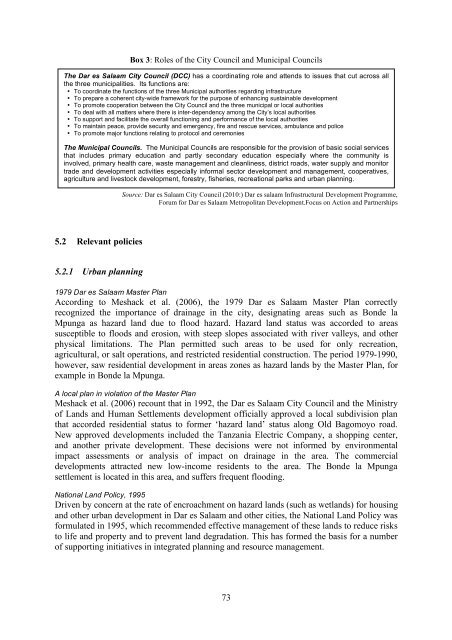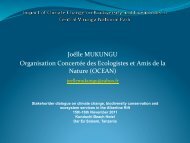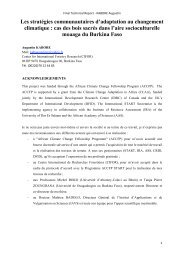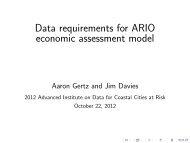Urban Poverty & Climate Change in Dar es Salaam, Tanzania:
Urban Poverty & Climate Change in Dar es Salaam, Tanzania:
Urban Poverty & Climate Change in Dar es Salaam, Tanzania:
Create successful ePaper yourself
Turn your PDF publications into a flip-book with our unique Google optimized e-Paper software.
Box 3: Rol<strong>es</strong> of the City Council and Municipal Councils<br />
The <strong>Dar</strong> <strong>es</strong> <strong>Salaam</strong> City Council (DCC) has a coord<strong>in</strong>at<strong>in</strong>g role and attends to issu<strong>es</strong> that cut across all<br />
the three municipaliti<strong>es</strong>. Its functions are:<br />
• To coord<strong>in</strong>ate the functions of the three Municipal authoriti<strong>es</strong> regard<strong>in</strong>g <strong>in</strong>frastructure<br />
• To prepare a coherent city-wide framework for the purpose of enhanc<strong>in</strong>g susta<strong>in</strong>able development<br />
• To promote cooperation between the City Council and the three municipal or local authoriti<strong>es</strong><br />
• To deal with all matters where there is <strong>in</strong>ter-dependency among the City’s local authoriti<strong>es</strong><br />
• To support and facilitate the overall function<strong>in</strong>g and performance of the local authoriti<strong>es</strong><br />
• To ma<strong>in</strong>ta<strong>in</strong> peace, provide security and emergency, fire and r<strong>es</strong>cue servic<strong>es</strong>, ambulance and police<br />
• To promote major functions relat<strong>in</strong>g to protocol and ceremoni<strong>es</strong><br />
The Municipal Councils. The Municipal Councils are r<strong>es</strong>ponsible for the provision of basic social servic<strong>es</strong><br />
that <strong>in</strong>clud<strong>es</strong> primary education and partly secondary education <strong>es</strong>pecially where the community is<br />
<strong>in</strong>volved, primary health care, waste management and cleanl<strong>in</strong><strong>es</strong>s, district roads, water supply and monitor<br />
trade and development activiti<strong>es</strong> <strong>es</strong>pecially <strong>in</strong>formal sector development and management, cooperativ<strong>es</strong>,<br />
agriculture and liv<strong>es</strong>tock development, for<strong>es</strong>try, fisheri<strong>es</strong>, recreational parks and urban plann<strong>in</strong>g.<br />
5.2 Relevant polici<strong>es</strong><br />
5.2.1 <strong>Urban</strong> plann<strong>in</strong>g<br />
Source: <strong>Dar</strong> <strong>es</strong> <strong>Salaam</strong> City Council (2010:) <strong>Dar</strong> <strong>es</strong> salaam Infrastructural Development Programme,<br />
Forum for <strong>Dar</strong> <strong>es</strong> <strong>Salaam</strong> Metropolitan Development.Focus on Action and Partnerships<br />
1979 <strong>Dar</strong> <strong>es</strong> <strong>Salaam</strong> Master Plan<br />
Accord<strong>in</strong>g to M<strong>es</strong>hack et al. (2006), the 1979 <strong>Dar</strong> <strong>es</strong> <strong>Salaam</strong> Master Plan correctly<br />
recognized the importance of dra<strong>in</strong>age <strong>in</strong> the city, d<strong>es</strong>ignat<strong>in</strong>g areas such as Bonde la<br />
Mpunga as hazard land due to flood hazard. Hazard land status was accorded to areas<br />
susceptible to floods and erosion, with steep slop<strong>es</strong> associated with river valleys, and other<br />
physical limitations. The Plan permitted such areas to be used for only recreation,<br />
agricultural, or salt operations, and r<strong>es</strong>tricted r<strong>es</strong>idential construction. The period 1979-1990,<br />
however, saw r<strong>es</strong>idential development <strong>in</strong> areas zon<strong>es</strong> as hazard lands by the Master Plan, for<br />
example <strong>in</strong> Bonde la Mpunga.<br />
A local plan <strong>in</strong> violation of the Master Plan<br />
M<strong>es</strong>hack et al. (2006) recount that <strong>in</strong> 1992, the <strong>Dar</strong> <strong>es</strong> <strong>Salaam</strong> City Council and the M<strong>in</strong>istry<br />
of Lands and Human Settlements development officially approved a local subdivision plan<br />
that accorded r<strong>es</strong>idential status to former ‘hazard land’ status along Old Bagomoyo road.<br />
New approved developments <strong>in</strong>cluded the <strong>Tanzania</strong> Electric Company, a shopp<strong>in</strong>g center,<br />
and another private development. Th<strong>es</strong>e decisions were not <strong>in</strong>formed by environmental<br />
impact ass<strong>es</strong>sments or analysis of impact on dra<strong>in</strong>age <strong>in</strong> the area. The commercial<br />
developments attracted new low-<strong>in</strong>come r<strong>es</strong>idents to the area. The Bonde la Mpunga<br />
settlement is located <strong>in</strong> this area, and suffers frequent flood<strong>in</strong>g.<br />
National Land Policy, 1995<br />
Driven by concern at the rate of encroachment on hazard lands (such as wetlands) for hous<strong>in</strong>g<br />
and other urban development <strong>in</strong> <strong>Dar</strong> <strong>es</strong> <strong>Salaam</strong> and other citi<strong>es</strong>, the National Land Policy was<br />
formulated <strong>in</strong> 1995, which recommended effective management of th<strong>es</strong>e lands to reduce risks<br />
to life and property and to prevent land degradation. This has formed the basis for a number<br />
of support<strong>in</strong>g <strong>in</strong>itiativ<strong>es</strong> <strong>in</strong> <strong>in</strong>tegrated plann<strong>in</strong>g and r<strong>es</strong>ource management.<br />
73







